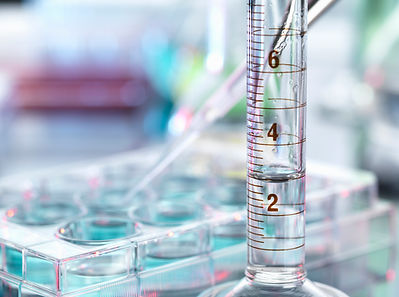

Chemistry Tools
We have a number of global adopters including Devnar School of the Blind, Hyderabad, India (> 500 blind students), NFBM Jagriti School For Blind Girls, Pune, India (> 500 blind students), Sai Blind School, rural village of Andhra Pradesh (25 blind students). Expressed interest from US blind schools in POSB conference.

Alternate text: Certain steps of this experiment are circled to emphasize that many experiments require chemists to identify color
Talking Color Sensor
Most chemistry experiments display some sort of visible reaction. For example, this total alkalinity experiment requires the chemist to identify the color of the solution at every key step. The image on the right shows the procedure of an experiment that finds the total alkalinity of water. The steps that involve identifying the color of the solution are circled for emphasis.
To aid visually impaired chemists, Donum Visi created a low-cost, talking color sensor. This system identifies the color of an object or solution and says aloud which color it recognizes. In the context of this experiment, a visually impaired chemist would know when the solution has changed colors by listening to the audio output from the sensor.
Talking Thermometer
Endothermic and exothermic reactions are very important fundamental concepts in chemistry, and there are hundreds of experiments that can help students understand them. Experiments like these involve the usage of external measurement tools such as thermometers. However, it is difficult for the visually impaired to read data from such tools without external assistance. The image shows a traditional thermometer in a beaker of water to show how it would be difficult for a visually impaired chemist to use such tools.
Donum Visi solves this problem with a low-cost, accurate, and waterproof talking thermometer. This tool has a wide range of uses and is easy to use. When it is turned on, it reads aloud the temperature at regular intervals.

Alternate Text: It would be difficult for a visually impaired chemist to read data from a traditional thermometer
Talking Water-Level Sensor

Alternate Text: All these images show experiments in which the first step requires the chemist to measure a water sample
Most chemistry experiments start off with instructions shown in the images. These are five images that come from various experiments. They show the first step of each experiment to demonstrate that many experiments begin with measuring a certain amount of a solution. The first step is to measure a certain amount of a sample. However, these tasks would be tough for visually impaired chemists to do accurately without outside assistance.
Donum Visi solves this problem with a low-cost, talking water level sensor. This sensor is placed in a graduated cylinder and speaks aloud when the water level has reached the bottom of the sensor. When the solution has reached that level, the sensor tells the chemist to stop pouring. In case the chemist is conducting an experiment where it is not possible for the sensor to make direct contact with the solution, we also have touch-free water-level sensors. These have the same functionality as the regular sensors, but they are placed on the surface of the graduated cylinder rather than inside.
Automated Pipette
Another common step that is repeated in nearly all chemistry experiments is depositing droplets using a pipette. For example, the total alkalinity experiment below requires the use of a pipette several times throughout the experiment.
The image shows the procedure of an experiment that finds the total alkalinity of water. The steps that involve the use of a pipette are circled for emphasis.
Visually impaired chemists would not be able to see precisely how many drops they are depositing, which is why Donum Visi’s automated pipette would be extremely useful in almost any experiment. It automatically transfers liquid from one source to another in droplets.
